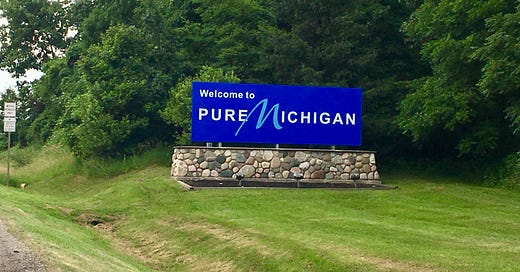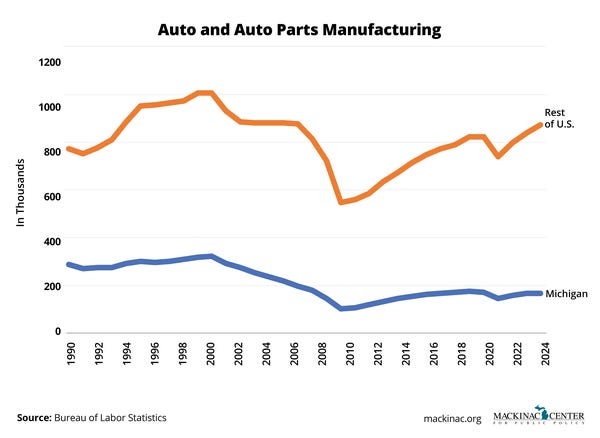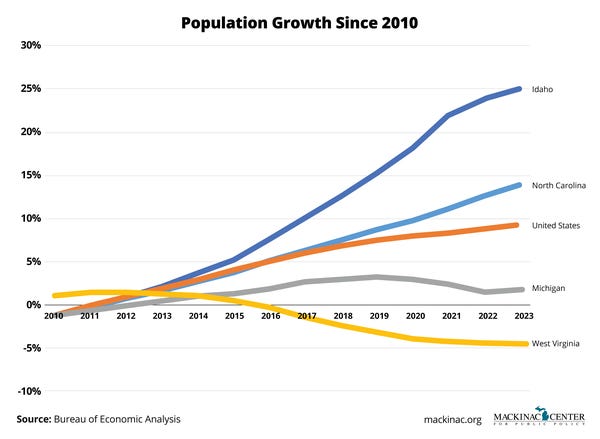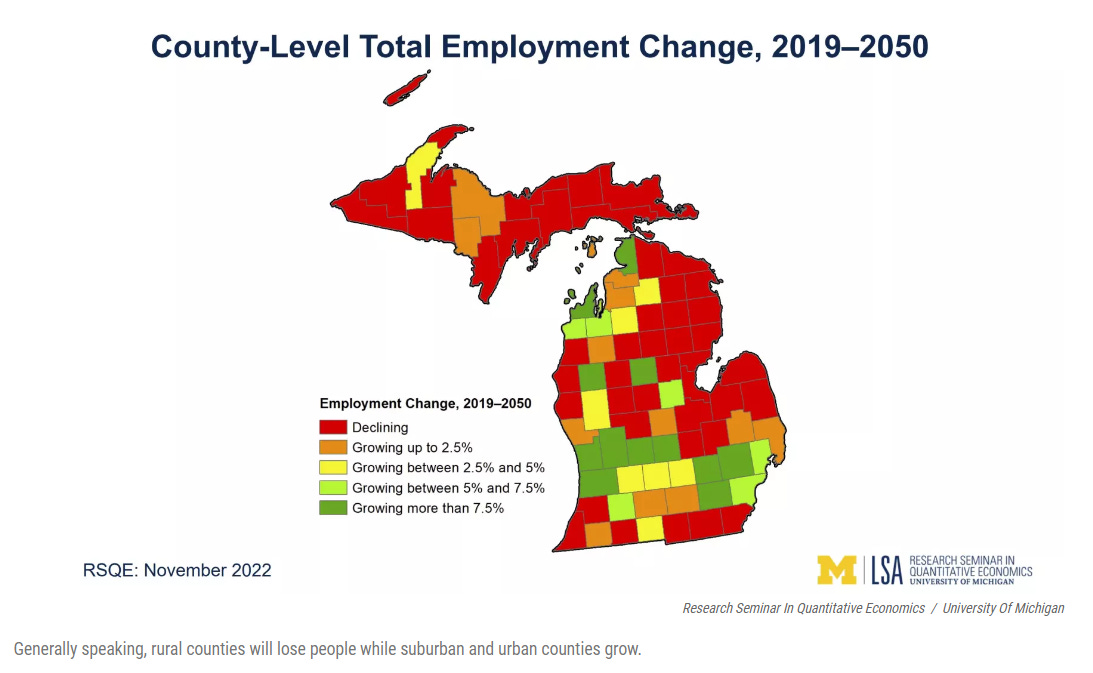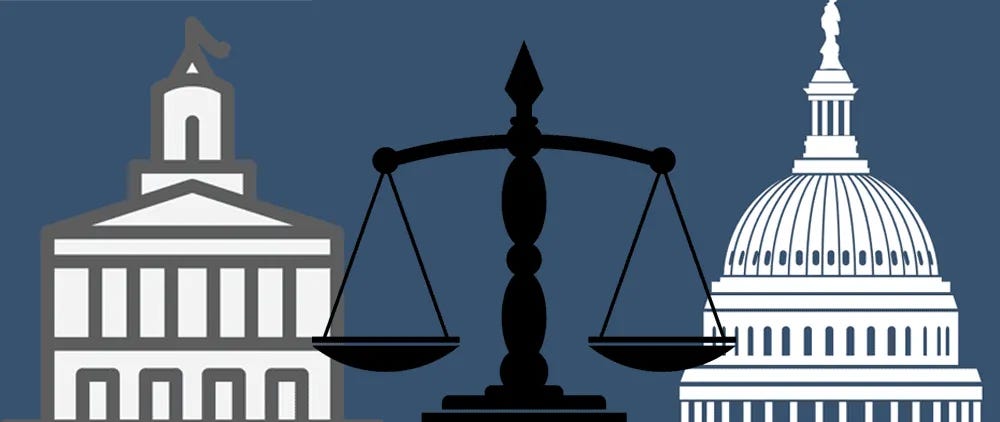Michigan, the Midwest, and the Forgotten Bits of America
The Great Lakes State is being submerged
Michigan stands as an example of what’s coming to large sections of the American heartland. The state was once one of the wealthiest polities in the world, Detroit was once the most affluent city on the planet, and Michiganders once enjoyed incomes significantly above the national average.
In the 1960s, at the height of American economic might, Michigan possessed the 6th largest economy in the United States. Ahead of states like Florida and Texas, and larger than most Western European nations at the time. Michiganders enjoyed a per capita income some 20 points (and thousands of dollars) higher than the national average. In 1963 the share of manufacturing as a part of Michigan’s GDP was just shy of 50% while the national average was roughly 27%. The state was a major exporter, a major shipping hub (see the now struggling Port of Detroit), and a place of sprawling prosperity.
The state’s demographics in the 1960s census were 90.4% White and 9.4% Black. These African Americans were transplants attracted to Detroit by its large automotive industry and the early arrivals had homeownership rates, rates of income, and rates of net worth much higher than the national average for African Americans at the time.
In short, Michigan was prospering and its strong White majority was among the most economically, socially, and culturally secure in the world.
Today, though, after decades of de-industrialization, financialization, free-trade practices, and cheap labor (to name but a few issues), Michigan is only the 14th largest economy in the nation. A ranking that continues to decline with each passing decade. Michigan’s homeownership rate, which once stood 16 points above the national average, is decreasing and now stands just 7 points above the average.
The once robust manufacturing economy has collapsed from its height of roughly 50% to a share of roughly 18% today (2024) while the number of automobile and parts manufacturing jobs has halved since 2000. This effect is compounded by the fact that Michigan suffered a single-state recession starting in 2000 that would later go on to merge with the eventual Great Recession of 2008. In the period from 2000 to 2009, Michigan lost 861,000 jobs, or 18% of all jobs in the state. This ‘structural transformation’ and the Great Recession have permanently dogged the Michigan economy, particularly in rural areas that still have not recovered from Great Recessione era losses.
Because of these continued economic losses, combined with social change and demographic inundation, the population of the state has become severely stagnant. In the 1950s and 1960s at the height of its prosperity, Michigan had a fertility rate which was significantly above the national average. While American women were having roughly 3.6 children during the peak of the baby boom women in Michigan were having roughly 4.2 children! This higher fertility rate persisted from the 1940s through the 1970s only to collapse when the era of free trade and neoliberal economics began to gut Michigan’s manufacturing-based economy.
By the 1980s Michigan’s fertility rate was well below the national average and has never again risen to meet it. While the country experienced a positive fertility rate above 2.1 from the 1990s to the early 2010s Michigan was consistently below this and often dipped closer to 1.5 TFR.
Today, as the overall national fertility rate collapses Michigan’s is once again staying ahead of the trend and imploding at an even more rapid rate. One small upside is that the White fertility rate continues to constitute roughly 70% of births in the state and has done so since roughly 2010, thereby offering some rough sense of demographic stability to many of Michigan’s communities.
But this steady fertility rate is not holding back the trend of demographic change sweeping the nation. Instead, Michigan’s sluggish economy is merely ensuring the Great Replacement happens more slowly than in other parts of the country. Though the state government of Gretchen Whitmer is very dedicated to speeding up this process.
The 2020 census showed that White Michigander’s share of the population had fallen to just 72.4% of the state’s overall demographic mix. This is a long way from the 94.7% White population of 1940 or the 90.6% White population of 1960. With each census, the White share of Michigan’s population declines by roughly 2.2% with a few larger drops in noticeable in the trend. This much slower decline means that it will be more than 100 years before Michigan becomes a minority White state (assuming trends hold) and may mean it will never become minority White, not least because its native-born minority populations are beginning to shrink.
African Americans in the state are entering a steep population decline. More than 50% of the majority African American localities in the state are now losing a significant Black population every year and the rapid aging of the African American population, combined with its extremely low and shrinking fertility rate, means that within a decade the Black populace will begin to ‘age out’ much faster than that of the population of White Michiganders.
In some cities, such as Bay City, Jackson, Detroit, or Flint the Black population shrunk by significant margins. Detroit’s Black population contracted by 16% or 93,361 individuals while Flint’s Black population contracted by 21% or 12,158 individuals.
These rapid population contractions will, regardless of one’s political view, significantly change the feeling and character of these communities and leave large portions of Michigan’s once prosperous cities now entirely depopulated in the same manner large sections of Detroit have been left devoid of inhabitants.
Still, none of this is particularly surprising. Michigan ranks among the lowest growth states for population increase since the year 2010 and if projections are to be believed negative population growth on par with West Virginia is in the state’s near future.
This population decrease is not limited to Michigan’s Black population.
Many rural White areas of the state are experiencing population decline, particularly in the Eastern portion of the state and in the culturally dissimilar Upper Peninsula. Many of these losses are modest for now with less than 5% population loss being the most common trend among Michigan counties. In the Western portion of the state modest growth of under 5% represents the current norm, but this is not expected to hold in the coming decades.
By 2050 the University of Michigan predicts that population decline will take effect in a large majority of Michigan counties, East or West, and that the state will lose over 700,000 residents over the next 26 years.
The state government is not sitting idly by, though. In fact, it is dedicated to increasing the demographic transformation of Michigan from a state and culture founded by Whites to an area inhabited by a large non-White population of recent immigrants.
The state of Michigan is providing rental assistance to "refugees and other immigrants" through a new program that will give these new residents up to 500 dollars per month. No such program exists for Michiganders, who are in dire need of help, and they must instead be directed toward a Federal HUD program for "very low-income" people.
Michigan has been in a slowly mounting housing crisis since April of 2023, and the problem is only growing worse as the state government seeks to build new housing around Michigan’s major southern cities (which house much of the non-White population) at the same time that the rural (and overwhelmingly White) Upper Peninsula and Northern Mitten face a severe housing shortage and cost increase.
The state has also launched the "Growing Michigan Together Council" which is designed to attract international migrants to the state, thereby compounding the housing crisis and increasing the number of people eligible for a program that Michiganders are unable to access.
The state is also putting together a strategy to retain young native-born Michiganders through its “Growing Together Council”, though it is hard to believe that this will work considering the youngest member of this council is in his 40s and most members are in their 60s.
This does not mean the state is without policy options, however.
The state, if its large conservative White majority could come out to elect a strong leader, could undertake efforts to remove the immigrant population from the state.
The state could, again if under the proper leadership, make efforts to spend public funds on increasing the manufacturing base and offering the middle class a new and better future than it currently faces. The use of public health laws and other restrictions could keep people from other regions of the United States from flooding into the state to eat up this newfound prosperity and Michigan could begin to slowly pull its way out of the cavern it finds itself trapped in.
But these are all big ifs and they are problems that many other states: Wisconsin, Indiana, Minnesota, Illinois, and Ohio are facing themselves.
If Michiganders and the other peoples of the forgotten heartland of America want to change their fortunes they must first recognize their cultural and ethnic inheritance is under threat, move to protect it, and put policies in place to ensure their descendants can enjoy a new form of prosperity.
But this will not happen if we do not fully understand the problem as it exists.
Support White Papers’ mission to investigate and promote pro-White policies!
Zelle: whitepapersinstitute@protonmail.com
Buy us a coffee: https://www.buymeacoffee.com/wppi
Linktree: https://linktr.ee/wppi
Snail Mail: White Papers Policy, PO Box 192, Hancock, MD 21750

